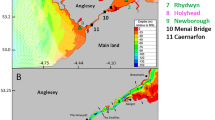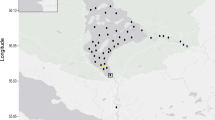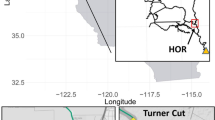Abstract
The demonstration of selective tidal stream transport in species as diverse as plaice, sole, cod, dogfish and eels suggests that the phenomenon may be of widespread significance in the migration of fishes on the European continental shelf. A computer simulation model has been written which interpolates the speed and direction of the tidal stream from the data given for the tidal diamonds on the appropriate British Admiralty Charts. The model allows for the cyclical change of current speed between neap and spring tides and includes three behavioural options for the fish: 1) semidiurnal vertical migration initiated at either slack water with a variable period of transport in midwater; 2) diurnal vertical migration with a variable ratio of time spent in midwater to time spent on the bottom; and 3) continuous transport (i.e. drift) in midwater. The aims of the model are to generate simulated tracks which: 1) taken individually, may lead to predictions about the behaviour of individual fish, which can be tested by further tracking experiments; and 2) taken collectively, may lead to predictions about the resulting distributions of whole populations, which can be tested by conventional tagging experiments. The first simulations have been concerned with the prespawning and postspawning migrations of plaice in the Southern Bight and English Channel and with the spawning migrations of silver European eels crossing the European shelf on their return to the Sargasso Sea. Some simulations have also been made of the tracks of plaice exhibiting diurnal vertical migrations on various feeding, spawning and staging grounds in the southern North Sea and English Channel.
Details are given of a series of semidiurnal tracks running from the southern North Sea through the Strait of Dover into the English Channel, and it is shown that the four centres of plaice spawning off Flamborough Head, in the Southern Bight and in the English Channel lie along a common streampath. A second series of semidiurnal tracks is used to predict the distributions of spent plaice migrating out of the Southern Bight into the central North Sea. The distributions are plotted on a lunar time base, and it is shown that fish contained within the area of peak spawning will use the western migration route. The diurnal tracks show that a fish adopting the diurnal mode of vertical migration will remain within a relatively confined locality even in areas of fast and directional tidal streams.
The simulated silver eel tracks show that a fish leaving the River Severn, England, should be able to reach the edge of the continental shelf to be the southwest of the British Isles in about 40 days by selective tidal stream transport. A fish from the River Humber, England, should similarly be able to reach the edge of the shelf by the northern North Sea in about 100 days. But there is a problem for eels using tidal stream transport from the River Elbe, West Germany. They would appear to become permanently trapped in the system of east-west tidal streampaths in the central North Sea and might fail to reach the edge of the continental shelf in sufficient time to complete the subsequent oceanic phase of the migration. An analogy is drawn between this apparent “tidal gyre” in the North Sea and the areas of the central North Pacific from which Pacific salmon fail to return to North America. An eel from Texel, The Netherlands, relying on tidal stream transport would similarly reverse in the English Channel in the area of dividing tidal streampaths to the west of the Cherbourg peninsula, France, and return to the North Sea. Reversal is also relevant to the migrations of the plaice and appears to be limited to tracks passing through the Straight of Dover within 20 km of Cap Gris Nez, France.
Future work will be concerned with extending the simulations to the distributions of other plaice stocks on the European shelf—and to other species such as cod and haddock—and to predictions aimed at furthering our understanding of the mechanism of selective tidal stream transport itself. The phenomenon of reversal, for example, suggests the possibility of conducting a sea-going experiment to determine whether the underlying mechanism is, as we suspect, based on a succession of temporal cues or instead involves an absolute sense of direction on the part of the fish.
Access this chapter
Tax calculation will be finalised at checkout
Purchases are for personal use only
Preview
Unable to display preview. Download preview PDF.
Similar content being viewed by others
References
Anonymous. 1968. Atlas der Gezeitenströme für die Nordsee, den Kanal und die Irische See. Seehydrographischer Dienst der Deutschen Demokratischen Republik, Second edition. Rostock, Democratic Republic of Germany.
Anonymous. 1978. Stroomatlas Waddenzee, westelijk deel. Dienst der Hydrografie van de Koninklijke Marine. ’s-Gravenhage, The Netherlands.
Anonymous. 1983. Atlas der Gezeitenströme in der Deutschen Bucht. Deutsches Hydrographisches Institut. Hamburg, Federal Republic of Germany.
Arnold, G.P. 1981. Movements of fish in relation to water currents. Pages 55–79 in D.J. Aidley, editor. Animal migration. Society for Experimental Biology. Seminar series 13. Cambridge University Press, Cambridge, England.
Clerck, R. de. 1977. The migration of plaice on the spawning grounds ’Noord-Hinder.’ International Council for the Exploration of the Sea. C.M. 1977/F:40. Demersal Fish (Northern) Committee (mimeo).
Cook, P.H. 1984. Directional information from surface swell: some possibilities. Pages 79–101 in J.D. McCleave, G.P. Arnold, J.J. Dodson and W.H. Neill, editors. Mechanisms of migration in fishes. Plenum Press, New York, New York, USA.
Creutzberg, F. 1961. On the orientation of migrating elvers (Anguilla vulgaris Turt.) in a tidal area. Netherlands Journal of Sea Research 1: 257–338.
Creutzberg, F., A. Th. G.W. Eltink, and G.J. van Noort. 1978. The migration of plaice larvae Pleuronectes platessa into the western Wadden Sea. Pages 243–251 in D.S. McLusky and A.J. Berry, editors. Physiology and behaviour of marine organisms. Pergamon Press, Oxford, England.
Cushing, D.H. 1972. The production cycle and the numbers of marine fish. Pages 213–232 in R.W. Edwards and D.J. Garrod, editors. Conservation and productivity of natural waters. Symposia of the Zoological Society of London 29. Academic Press, London, England.
Davies, A.M. 1979. Role of 2D and 3D models in JONSDAP’76. Pages 1085–1103 in Proceedings of the 16th Coastal Engineering Conference, Hamburg, 1978, volume 1. American Society of Civil Engineers, New York, New York, USA.
Davies, A.M. 1981. Three dimensional hydrodynamic numerical models. Part 1, A homogeneous ocean-shelf model. Part 2, A stratified model of the northern North Sea. Pages 370–426 in R. Saetre and M. Mork, editors. The Norwegian coastal current, volume 2. University of Bergen, Bergen, Norway.
Defant, A . 1958. Ebb and flow. The University of Michigan Press, Ann Arbor, Michigan, USA. Duwe, K.C., and R.R. Hewer. 1982. Ein semi-implizites Gezeitenmodell für Wattgebiete. Deutsche Hydrographische Zeitschrift 35: 223–238.
Duwe, K.C., R.R. Hewer. 1982. Ein semi-implizites Gezeitenmodell für Wattgebiete. Deutsche Hydrographische Zeitschrift 35: 223–238.
Forster, G.R. 1953. The spawning behaviour of plaice. Journal of the Marine Biological Association of the United Kingdom 32: 319.
Gould, W.J . 1978. Currents on continental margins and beyond. Philosophical Transactions of the Royal Society, London. A. 290: 87–98.
Greer Walker, M., F.R. Harden Jones, and G.P. Arnold. 1978. The movements of plaice (Pleuronectes platessa L.) tracked in the open sea. Journal du Conseil Conseil International pour 1’Exploration de la Mer 38: 58–86.
Groot, S.J. de. 1981. Dutch observations on rare fish in 1979. Annales Biologiques. Conseil International pour 1’Exploration de la Mer 36 (1979): 196.
Harden Jones, F.R. 1968. Fish migration. Arnold, London, England.
Harden Jones, F.R. 1977. Performance and behaviour on migration. Pages 145–170 in J.H. Steele, editor. Fisheries mathematics. Academic Press, London, England.
Harden Jones, F.R. 1980. The migration of plaice (Pleuronectes platessa) in relation to the environment. Pages 383–399 in J.E. Bardach, J.J. Magnuson, R.C. May and J.M. Reinhart, editors. Fish behavior and its use in the capture and culture of fishes. ICLARM, Manila, Philippines.
Harden Jones, F.R. 1981. Fish migration: strategy and tactics. Pages 139–165 in D.J. Aidley, editor. Animal migration. Society for Experimental Biology. Seminar series 13. Cambridge University Press, Cambridge, England.
Harden Jones, F.R. 1984a. A view from the ocean. Pages 1–26 in J.D. McCleave, G.P. Arnold, J.J. Dodson and W.H. Neill, editors. Mechanisms of migration in fishes. Plenum Press, New York, New York, USA.
Harden Jones, F.R. 1984b. Could fish use inertial clues when on migration? Pages 67 - 78 in J.D. McCleave, G.P. Arnold, J.J. Dodson and W.H. Neill, editors. Mechanisms of migration in fishes. Plenum Press, New York, New York, USA.
Harden Jones, F.R., M. Greer Walker, and G.P. Arnold. 1978. Tactics of fish movement in relation to migration strategy and water circulation. Pages 185–207 in Henry Charnock and Sir George Deacon, editors. Advances in oceanography. Plenum Press, New York, New York, USA.
Harden Jones, F.R., G.P. Arnold, M. Greer Walker, and P. Scholes. 1979. Selective tidal stream transport and the migration of plaice (Pleuronectes platessa L.) in the southern North Sea. Journal du Conseil Conseil International pour 1’Exploration de la Mer 38: 331–337.
Harden Jones, F.R., and G.P. Arnold. 1982. Acoustic telemetry and the marine fisheries. Pages 75–93 in C.L. Cheeseman and R.B. Mitson, editors. Telemetrie studies of vertebrates. Symposia of the Zoological Society of London 49. Academic Press, London, England.
Harding, D., J.E. Nichols, and D.S. Tungate. 1978. The spawning of plaice (Pleuronectes platessa L.) in the southern North Sea and English Channel. Rapports et Procès-verbaux des Reunions. Conseil International pour l’Exploration de la Mer 172: 102–113.
Houghton, R.G., and D. Harding. 1976. The plaice of the English Channel: spawning and migration. Journal du Conseil Conseil International pour 1’Exploration de la Mer 36: 229–239.
Lee, A.J., and J.W. Ramster. 1981. Atlas of the seas around the British Isles. Ministry of Agriculture, Fisheries and Food, Lowestoft, England.
Macer, C.T. 1972. The movements of tagged adult plaice in the Irish Sea. Fishery Investigations, London. Series 2, 27 (6): 1–41.
Mitson, R.B., and T.J. Storeton-West. 1971. A transponding acoustic fish tag. The Radio and Electronic Engineer 41: 483–489.
Rauck, G. 1977. Two German plaice tagging experiments (1970) in the North Sea. Archiv für Fischereiwissenschaft 28: 57–64.
Rijnsdorp, A.D., and M. van Stralen. 1982. Selective tidal migration of plaice larvae (Pleuronectes platessa L.) in the Easterscheldt and the western Waddensea. International Council for the Exploration of the Sea. C.M. 1982/G:31 Demersal Fish Committee (mimeo).
Simpson, A.C. 1959. The spawning of the plaice (Pleuronectes platessa) in the North Sea. Fishery Investigations, London. Series 2, 22 (7): 1–111.
Veen, J. van. 1938. Water movements in the Straits of Dover. Journal du Conseil Conseil International pour 1’Exploration de la Mer 13: 7–36.
Veen, J.F. de. 1978. On selective tidal transport in the migration of North Sea plaice (Pleuronectes platessa) and other flatfish species. Netherlands Journal of Sea Research 12: 115–147.
Voglis, G.M., and J.C. Cook. 1966. Underwater applications of an advanced acoustic scanning equipment. Ultrasonics 4: 1–9.
Weihs, D. 1978. Tidal stream transport as an efficient method for migration. Journal du Conseil Conseil International pour 1’Exploration de la Mer 38: 92–99.
Author information
Authors and Affiliations
Editor information
Editors and Affiliations
Rights and permissions
Copyright information
© 1984 British
About this chapter
Cite this chapter
Arnold, G.P., Cook, P.H. (1984). Fish Migration by Selective Tidal Stream Transport: First Results with a Computer Simulation Model for the European Continental Shelf. In: McCleave, J.D., Arnold, G.P., Dodson, J.J., Neill, W.H. (eds) Mechanisms of Migration in Fishes. NATO Conference Series, vol 14. Springer, Boston, MA. https://doi.org/10.1007/978-1-4613-2763-9_15
Download citation
DOI: https://doi.org/10.1007/978-1-4613-2763-9_15
Publisher Name: Springer, Boston, MA
Print ISBN: 978-1-4612-9708-6
Online ISBN: 978-1-4613-2763-9
eBook Packages: Springer Book Archive




